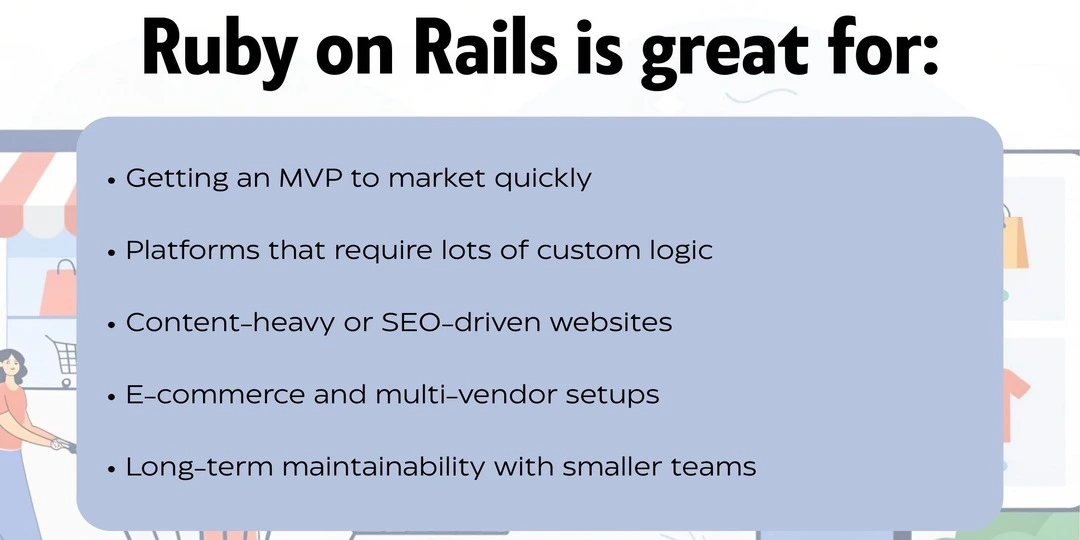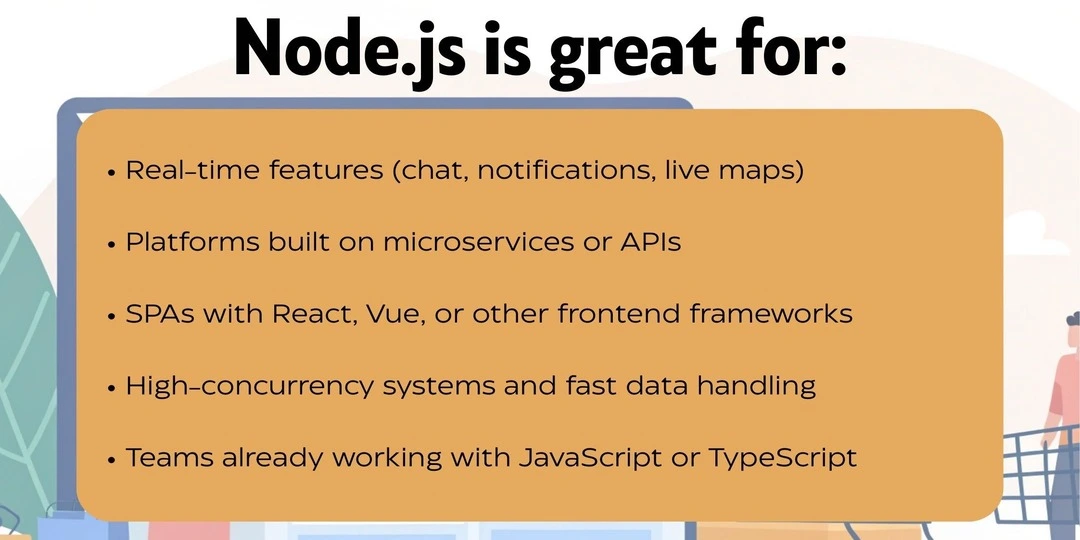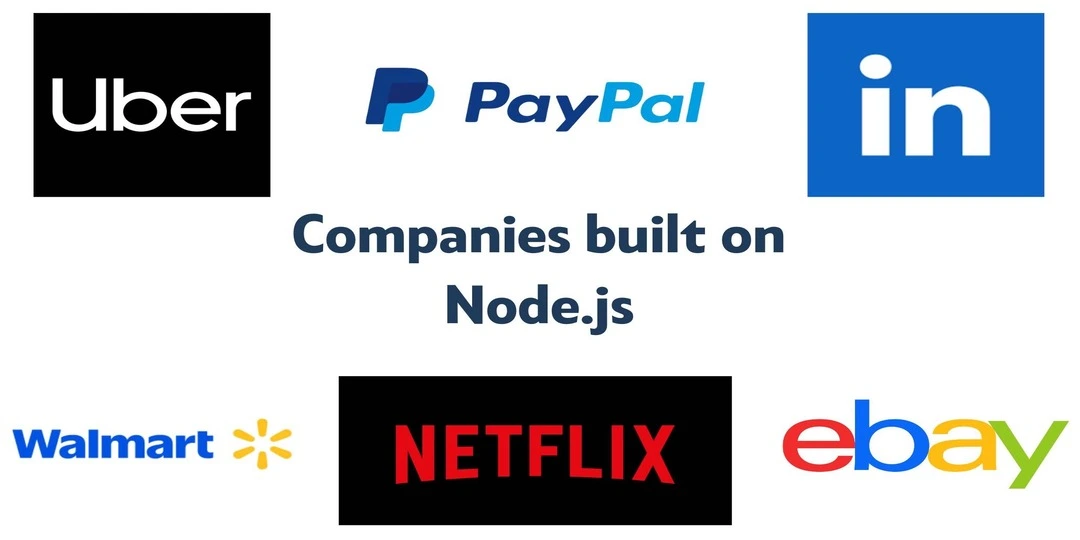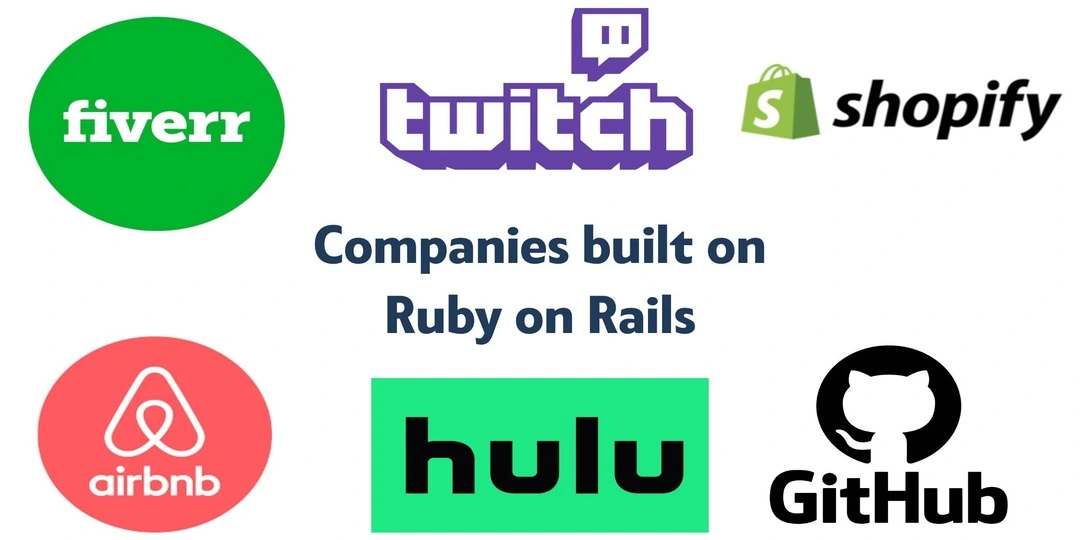All those super-slick marketplaces you see operating today are driven by a tech stack that leads the way. In 2025, digital marketplaces are evolving faster than ever, and so is the pressure to choose the right backend framework. The Node.js vs Ruby on Rails debate is one that many founders face. Get it right, and you accelerate your time to market, streamline operations, and scale confidently. Get it wrong, and you risk spiraling costs, performance headaches, and technical debt that slows you down just when things start to take off.
We support the creation of digital ecosystems at Roobykon Software. We’ve partnered with marketplace founders across the globe, helping them compare Ruby on Rails to Node.js in real-world conditions – not just in theory. These two technologies dominate conversations for a reason: each brings a compelling set of strengths to the table, especially when building complex, multi-sided platforms.
In some projects, we’ve even implemented Node.js with Ruby on Rails in a hybrid setup to maximize the unique benefits of both – a move that can give your platform the best of both worlds.
This isn’t your average tech-stack checklist. It’s a boots-on-the-ground comparison drawn from building, scaling, and maintaining real-world marketplaces.
Overview: Ruby on Rails and Node.js in 2025
Before we dive into benchmarks, let’s zoom out for a moment. If you’re building an online marketplace in 2025, there’s a good chance you’ve heard two names come up again and again: Ruby on Rails and Node.js. But what do they actually mean – and more importantly, how do you decide why use Rails instead of Node or when Node.js might be the better fit?
Let’s break them down in plain English.
Ruby on Rails in 2025: still fast, friendly, and surprisingly powerful
Ruby on Rails (or just Rails) has been around for a while, and it’s earned its reputation as one of the most developer-friendly web frameworks out there. Built on the Ruby programming language, Rails follows the MVC (Model-View-Controller) architecture and leans into a philosophy known as “Convention over Configuration.” What does that mean in practice? You can spin up features incredibly fast because Rails already has smart defaults for most of the things you’d otherwise need to configure manually – one of the reasons the performance of Ruby on Rails continues to impress even in 2025.
In a nutshell: less boilerplate, more building.
Despite its age (it’s pushing 20 years now), Rails is anything but outdated. With Rails 8.0 released at the end of 2024, the framework introduced some great performance upgrades, better encryption support, and tools for more API-friendly architectures. It’s grown up, but it hasn’t lost its speed or charm. It’s grown up, but it hasn’t lost its speed or charm – one of the key reasons founders ask why choose Ruby on Rails over other frameworks.
Another big win is the RubyGems ecosystem. Want user authentication? Payments? Background jobs? Admin dashboards? There’s probably a gem for that, well-tested and ready to plug in. This means your team spends less time solving solved problems and more time building the unique parts of your marketplace.

If you’re asking yourself, “Should I choose Node or Ruby for my startup?” – the answer will depend on your speed-to-market goals, technical needs, and team size. But if you want to launch fast, iterate often, and build something solid that won’t fall apart under pressure, Rails is still a fantastic choice.
Node.js in 2025: fast, flexible, and built for scale
Now, Node.js takes a different approach. It’s a JavaScript runtime environment, which basically means you can run JavaScript on the backend, not just in the browser. That’s huge. And since JavaScript is the most widely known programming language in the world, Node makes it easier to build full-stack teams where everyone speaks the same language. When you compare Ruby on Rails with Node.js, this shared language advantage is often one of the first benefits teams notice.
What really makes Node stand out is its non-blocking, event-driven architecture. That’s just a fancy way of saying it can handle lots of things at once, without slowing down. It’s ideal for real-time apps (think chat features, ride-tracking, live dashboards, booking engines) where you need fast responses and high concurrency – one of the differences between Node.js and Ruby on Rails that often influences tech stack decisions.
As of 2025, Node is more popular than ever. Its massive ecosystem, powered by npm (which now has over 2 million packages), gives you access to every kind of tool and library you can imagine, from lightweight frameworks like Express to more structured ones like NestJS. That flexibility is amazing, but it also means you’ll need a clear plan when architecting your platform. Unlike Rails, Node doesn’t tell you how to build. It just gives you the tools. So if you’re wondering, “Is Node.js like Ruby on Rails?” the answer is – not really. Rails gives you a guided path; Node gives you an open field.

If your marketplace is highly interactive, needs to scale to thousands of users in real time, or you’re building something modular from the start, Node.js gives you the flexibility to go big from day one. And for certain high-concurrency, event-heavy applications, it’s clear why Node is better than Rails for meeting those demands.
Performance & Scalability
For marketplace platforms in launch or growth phases, performance and scalability are business-critical. Your backend architecture needs to keep up with growth, deliver fast user experiences, and handle unpredictable spikes in traffic without melting down. Deciding between Node.js and Ruby on Rails often comes down to a Ruby on Rails vs Node.js performance assessment – and knowing how each behaves under real-world load will help you choose the right backend technology.
We’ll unpack how Node.js and Ruby on Rails compare in terms of speed under pressure and their ability to scale when your user base starts to grow fast (or all at once).
Performance: who’s faster under load?
When raw speed and responsiveness matter (especially in apps handling tons of simultaneous requests), Node.js tends to have the upper hand. In a Node.js vs Ruby on Rails performance discussion, this is often the deciding factor for high-concurrency platforms.
Why? It comes down to how it works under the hood. Node is built on Chrome’s V8 JavaScript engine and uses a non-blocking, event-driven architecture. This means a single Node process can juggle thousands of concurrent connections without waiting for one to finish before starting the next. It’s like having a highly efficient multitasker managing your server room, quick, lean, and ready for high-intensity workloads.
Node has only gotten faster over time. With Worker Threads, it can now even tackle CPU-bound tasks more efficiently. Real-world results back this up: when PayPal switched part of their backend from Java to Node.js, they doubled requests per second and cut response times by 35%.
So if your marketplace includes real-time messaging, live booking updates, notifications, or anything high-concurrency, Node is built to thrive in that environment.
Now, let’s talk about Rails.
Rails runs on Ruby – a language focused on developer happiness and elegant code, not squeezing every last drop of processing power. It’s interpreted, abstracted, and a bit heavier under the hood. By default, Rails apps are what we’d call CPU-intensive; they do more per request and aren’t naturally built for handling tons of connections simultaneously.
Plus, Ruby has something called the Global Interpreter Lock (GIL), which means only one thread can execute Ruby code at a time in most situations. That’s a bottleneck for concurrency, especially when compared to Node – and it’s a critical point in any Ruby on Rails comparison with other backend technologies.
But here’s the twist: Rails has been catching up.
- Ruby 3 introduced features like Ractors and async schedulers to help with parallelism.
- Rails 7 and 8 now support things like thread pooling, hotwire for realtime updates, and asynchronous tasks.
In practice, Ruby on Rails performance comparison tests show that for typical web apps (dashboards, profiles, listings, admin panels), Rails performs more than adequately – especially if your team uses caching, background jobs, and query optimization effectively.
But when performance is mission-critical (like supporting thousands of live connections or high-frequency I/O), Node.js wins this round.
✅ Winner (Performance): Node.js
It’s fast, light, and highly optimized for real-time, high-load use cases. Rails can hold its own in many common scenarios, but if speed at scale is non-negotiable, Node remains the go-to choice when you wonder how to choose a backend framework.
Scalability: growing pains or growth engine?
Performance is about speed, but scalability is about endurance. Can your backend grow with you, adapt to changing demands, and support spikes in usage without dragging your UX down? The Ruby on Rails or Node.js question often comes into focus here – because your choice can determine how gracefully your platform handles long-term growth.
Here again, Node.js is a strong contender out of the gate. Its architecture naturally fits into modern, cloud-native systems. Want to go microservices? Run serverless functions? Auto-scale containers across Kubernetes clusters? Node plays nicely with all of that – making it a popular choice when selecting an online marketplace framework for high-growth platforms.
Its lightweight, stateless model makes it easy to spin up new instances or services as needed. In fact, Node.js for microservices has become a proven pattern for some of the biggest names in tech. Companies like Netflix and Uber scale their infrastructures by running Node services that scale horizontally on demand, ensuring they can handle massive traffic spikes without a hitch.

Plus, with tools like Docker, Kubernetes, and the endless flexibility of npm, Node is practically made for building elastic systems that grow with your user base.
What about Rails?
Historically, Rails apps were built as monoliths – big, cohesive applications that handled everything in one place. And while that’s great for development speed early on, scaling a monolith can get tricky once you hit high traffic or complex operations.
That said, the Ruby on Rails language can absolutely scale, and companies like Shopify and Airbnb have proven it at massive levels. They’ve just had to put in the work: optimizing databases, using job queues like Sidekiq, adding read replicas, and leveraging caching layers to reduce load. Rails also supports API-only modes and service-oriented architecture, even if that’s not its default pattern.

With modern infrastructure and a thoughtful DevOps strategy, you can scale a Rails app to millions of users, but it’ll likely require more effort, tuning, and server resources than a lighter-weight Node stack.
✅ Winner (Scalability): Node.js
If you’re aiming for a cloud-native, event-driven, or microservices architecture (and you want the ability to grow fast with minimal friction), the Node.js backend framework gives you that flexibility right out of the box. Rails can grow, too, but it may need a bit more engineering muscle to get there.
Development speed & Developer experience
Getting a new idea off the ground, seeking investor traction, beating a competitor to market, your tech stack must enable your team to move fast and stay sane.
This is where developer experience and development speed come into play. And in this department, Ruby on Rails and Node.js take two very different, but equally interesting approaches. If you’ve ever done a Ruby on Rails speed comparison with backend Node.js, you’ll know each brings distinct strengths to the table.
Ruby on Rails: built for developer happiness and MVP velocity
Ruby on Rails was practically designed for MVPs and startups. Since its inception, Ruby on Rails for MVP development and Ruby on Rails for startups has embraced one core principle: developer happiness = developer productivity.
Rails is opinionated in the best way possible. It follows the philosophy of “Convention over Configuration,” meaning you spend less time deciding how to do things and more time actually doing them. There’s usually one clear, elegant path forward, so you’re not bogged down in choices about folder structure, routing, or setup – a key benefit that often stands out in any Ruby on Rails website framework comparison.
- Need to spin up a CRUD interface? Rails gives you scaffolding out of the box.
- Need a database migration? One command.
- Need routing, testing, or an admin panel? Rails has your back.
It’s a “batteries-included” framework, meaning most of what you need for Ruby on Rails backend development is already baked in. No need to hunt down packages for basics – it’s all there, well-documented, and battle-tested.
For small teams or early-stage startups, this can be a massive advantage. You can go from idea to working prototype in days, not weeks. That’s why even in 2025, the Ruby on Rails backend remains the secret weapon for many founders and CTOs who value speed, simplicity, and clean, maintainable code.
Node.js: one language, total flexibility
Now, Node.js offers a different kind of developer experience, and one that makes a lot of sense in the modern full-stack world.
Since Node runs on JavaScript (or more often, TypeScript in 2025), your developers can use the same language on both the frontend and the backend. That creates a unified workflow, tighter integration between services, and less cognitive switching for full-stack teams. It’s a major plus if you’re already building the frontend with React, Vue, or Svelte, and want to streamline Node.js backend development under the same language umbrella.
When you compare Ruby on Rails and Node.js, one of the biggest contrasts is flexibility. Node gives you the freedom to choose. You’re not locked into one way of doing things; you can pick your favorite framework (Express, Koa, NestJS), your preferred tools, and your own app structure. This flexibility is empowering… but it can also slow you down.
Unlike Rails, Node doesn’t hand you a fully baked cake; it gives you ingredients and lets you choose the recipe. For experienced teams, this means ultimate control. For newcomers, it can lead to decision fatigue or fragmented architecture if there’s no clear technical lead.
Still, if your team is already fluent in JavaScript or TypeScript, the familiarity with Node makes onboarding easier. And once your architecture is in place, building APIs, services, and integrations can be just as fast and fluid as in Rails – though in pure Node vs Ruby speed comparisons, Node often has the edge for highly concurrent, event-driven workloads.
So which one’s better for developers?
The high scalability of Ruby on Rails wins on quick starts and rapid prototyping. It feels like magic: fewer lines of code, less setup, and tons of power right out of the gate. You can move incredibly fast, and still write code that’s clean, testable, and maintainable.
Node.js wins on flexibility and language consistency. It’s great for building highly customized systems, especially if you’re working in a JS-heavy environment or sharing logic between frontend and backend.
In terms of developer experience, both Ruby and Node.js frameworks are mature, well-supported, and loved by their communities, but they cater to slightly different mindsets:
Rails | Node.js |
Structured, convention-based | Flexible, unopinionated |
Fast for MVPs | Great for modular apps and APIs |
Ruby-focused talent pool | Huge JavaScript/TypeScript ecosystem |
Built-in features | Pick-your-own-stack style |
✅ Winner (Developer productivity): Tie
It depends on your team and goals. Choose Rails if you’re racing to launch with a lean team and want maximum output with minimal decisions. Choose Node if you’re building a highly customized system, need frontend-backend synergy, or already have JS developers on board.
Final thoughts
As you see, there’s no universal winner in the Rails vs Node for a startup debate. The right choice depends entirely on what you’re building, who’s on your team, and how fast you need to move. It’s not about picking sides; it’s about picking what works for your unique context – whether that’s optimizing for Ruby on Rails scalability or leveraging the flexibility of Node.js.
💡 Choose Ruby on Rails if:
- You need to get an MVP off the ground fast and want to build on a framework that handles a ton of the heavy lifting for you.
- Your app relies on traditional web app structures (think forms, user accounts, dashboards), where Rails really shines.
- You want an opinionated, stable environment that helps your team move quickly without reinventing the wheel every week.
- You see potential to leverage Ruby on Rails microservices in the future while still benefiting from Rails’ structured approach today.
⚙️ Choose Node.js if:
- Your app is real-time by nature – chat apps, live notifications, collaborative tools, etc.
- You’re building out a microservices architecture or plan to scale horizontally from day one.
- You’re dealing with event-heavy or I/O-intensive workflows, like streaming or IoT integrations.
- You need maximum flexibility and want to shape your architecture without any constraints from a built-in framework.
Need a second opinion?
Roobykon has spent the last decade helping companies choose the right stack for their business, and then building platforms that actually deliver results.
We don’t play favorites. We play smart.
If you’re debating Node vs Ruby benchmark results – or just trying to make sense of what tech stack makes the most sense for your next big move – let’s talk. We’ll help you map it out, weigh the tradeoffs, and move forward with confidence.
If you’re looking for inspiration, check out our Ruby on Rails project examples to see how we’ve helped businesses thrive.
And if you’re ready to build, our expert Ruby on Rails developers are here to bring your vision to life.
Recommended articles
 Why Ruby on Rails is the best choice for startups in 2025
Why Ruby on Rails is the best choice for startups in 2025Despite the ever-evolving tech landscape, Ruby on Rails isn't just surviving – it's thriving. In 2025, its mature and robust ecosystem provides a stable foundation, while its legendary developer velocity allows startups to rapidly iterate and launch. Here’s why it’s more relevant than ever.
 TOP Ruby on Rails Project Ideas in 2025
TOP Ruby on Rails Project Ideas in 2025Is Ruby on Rails dying? Not even close. Explore Ruby on Rails business ideas, scaling strategies, and real-life success stories. See how industries from education to real estate still rely on Rails, with project examples and smart tech integrations.
 How to Track and Reduce Your Marketplace’s Carbon Footprint
How to Track and Reduce Your Marketplace’s Carbon FootprintOver 1,000 companies are pledging net-zero goals, and digital platforms are next. Discover practical ways to measure and lower your marketplace’s carbon footprint from the codebase to the cloud.
 Top Reasons to Opt for Software Project Development Outsourcing
Top Reasons to Opt for Software Project Development OutsourcingStruggling to meet development deadlines or facing a shortage of skilled talent? Explore the compelling reasons why outsourcing your software projects can be the solution you've been seeking.






